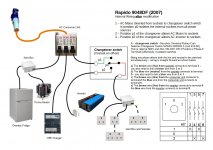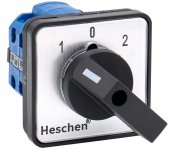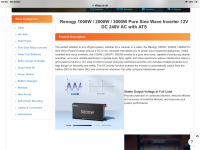You are using an out of date browser. It may not display this or other websites correctly.
You should upgrade or use an alternative browser.
You should upgrade or use an alternative browser.
I am thinking of fitting a inverter
- Thread starter Sonar
- Start date
Pudsey Bear
Full Member
- Messages
- 14,131
Guessing, If it's a ring main and not connected to the EHU income, anywhere, but if it is effectively just spurred, I think as near the centre (socket 3/4) as possible but as short a run from the LBs as possible.
If the sockets are connected to the EHU then it's not a great idea without a lot of messing about, I kept my inverter sockets totally separate.
If the sockets are connected to the EHU then it's not a great idea without a lot of messing about, I kept my inverter sockets totally separate.
Sonar
Free Member
- Messages
- 786
There all connected to the EHU. I really was hoping for an easy install but still if it means dedicated sockets then I am not sure how I will do it YETGuessing, If it's a ring main and not connected to the EHU income, anywhere, but if it is effectively just spurred, I think as near the centre (socket 3/4) as possible but as short a run from the LBs as possible.
If the sockets are connected to the EHU then it's not a great idea without a lot of messing about, I kept my inverter sockets totally separate.
Pudsey Bear
Full Member
- Messages
- 14,131
It can be done but it's not a simple install.
Do a search on the builder sister site for more info.
Do a search on the builder sister site for more info.
mistericeman
Full Member
- Messages
- 796
I have 2 sockets in the back of the wardrobe ....
One is powered by the hook up cable
The other is wired to the inverter ....
The consumer unit is fitted with a 3 pin plug
And I plug the consumer unit into whichever power source is available ....
Inverter/mains hook up ..
There are change over switches (auto/manual) available but as 99% of the time were not on hook up I didn't see the point myself .
It's important that at no time can ANY lead with exposed pins on the plug be live .
One is powered by the hook up cable
The other is wired to the inverter ....
The consumer unit is fitted with a 3 pin plug
And I plug the consumer unit into whichever power source is available ....
Inverter/mains hook up ..
There are change over switches (auto/manual) available but as 99% of the time were not on hook up I didn't see the point myself .
It's important that at no time can ANY lead with exposed pins on the plug be live .
Pudsey Bear
Full Member
- Messages
- 14,131
It's important that at no time can ANY lead with exposed pins on the plug be live .I have 2 sockets in the back of the wardrobe ....
One is powered by the hook up cable
The other is wired to the inverter ....
The consumer unit is fitted with a 3 pin plug
And I plug the consumer unit into whichever power source is available ....
Inverter/mains hook up ..
There are change over switches (auto/manual) available but as 99% of the time were not on hook up I didn't see the point myself .
It's important that at no time can ANY lead with exposed pins on the plug be live .
Could you plug it into a dummy socket for safety?
wildebus
Full Member
- Messages
- 7,453
In my experience, the most variable product it is possible to buy for a Motorhome is an "inverter". You can spend a lot of money on a quality one; you can spend a lot of money on a so-so one; you can spend an middling amount of money on a so-so one or on a crap one'; you will never spend a small amount of money on a decent one.
Do you need the inverter to be running when you are not there? If so, you need a proper quality one you don't have to worry about
Do you need the inverter to be running overnight or when you are just chilling? Many inverters have loud fans that can be very intrusive.
Some people use an inverter for a very specific purpose - say running a microwave or coffee machine. In those cases, you can switch it on when you need it, off when finished and it is only on for a few minutes at a time, always with you there and the noise of the MW or coffee machine will be louder than any inverter fan. In that case, a so-so inverter will be fine.
If you are using it to run a fridge - so could come on at any time - or a laptop charger - so don't want it to be loud - you would want an Inverter you can be comfortable not thinking about (i.e. a quality one).
Got two main options with sockets ...
1) have dedicated sockets used just for the inverter
2) tap into the consumer unit and fit a transfer switch so the sockets on the circuit you tapped into will work on both.
REMEMBER: YOU MUST NEVER HAVE THE EHU POWER AND INVERTER CONNECTED TOGETHER.
Personally speaking, I would only recommend Victron Inverters. Not saying they are the only option, just the only ones I would supply and fit myself.
Do you need the inverter to be running when you are not there? If so, you need a proper quality one you don't have to worry about
Do you need the inverter to be running overnight or when you are just chilling? Many inverters have loud fans that can be very intrusive.
Some people use an inverter for a very specific purpose - say running a microwave or coffee machine. In those cases, you can switch it on when you need it, off when finished and it is only on for a few minutes at a time, always with you there and the noise of the MW or coffee machine will be louder than any inverter fan. In that case, a so-so inverter will be fine.
If you are using it to run a fridge - so could come on at any time - or a laptop charger - so don't want it to be loud - you would want an Inverter you can be comfortable not thinking about (i.e. a quality one).
Got two main options with sockets ...
1) have dedicated sockets used just for the inverter
2) tap into the consumer unit and fit a transfer switch so the sockets on the circuit you tapped into will work on both.
REMEMBER: YOU MUST NEVER HAVE THE EHU POWER AND INVERTER CONNECTED TOGETHER.
Personally speaking, I would only recommend Victron Inverters. Not saying they are the only option, just the only ones I would supply and fit myself.
Cooperman
Full Member
- Messages
- 37
If you get an inverter like the Victron multiplus the place to connect it is in line between the electric hook up cable when it enters your motorhome and the feed to the consumer unit (Circuit breakers) you then connect your Leisure batteries to the Multiplus via Suitably sized cables and fuse links. Therefore siting the multiplus as close to the batteries as possible is desirable. The size of the multiplus will depend on how much 240V equipment you use simultaneously ie. total watts
Sonar
Free Member
- Messages
- 786
We thought it would be about 1 k.In my experience, the most variable product it is possible to buy for a Motorhome is an "inverter". You can spend a lot of money on a quality one; you can spend a lot of money on a so-so one; you can spend an middling amount of money on a so-so one or on a crap one'; you will never spend a small amount of money on a decent one.
Do you need the inverter to be running when you are not there? If so, you need a proper quality one you don't have to worry about
Do you need the inverter to be running overnight or when you are just chilling? Many inverters have loud fans that can be very intrusive.
Some people use an inverter for a very specific purpose - say running a microwave or coffee machine. In those cases, you can switch it on when you need it, off when finished and it is only on for a few minutes at a time, always with you there and the noise of the MW or coffee machine will be louder than any inverter fan. In that case, a so-so inverter will be fine.
If you are using it to run a fridge - so could come on at any time - or a laptop charger - so don't want it to be loud - you would want an Inverter you can be comfortable not thinking about (i.e. a quality one).
Got two main options with sockets ...
1) have dedicated sockets used just for the inverter
2) tap into the consumer unit and fit a transfer switch so the sockets on the circuit you tapped into will work on both.
REMEMBER: YOU MUST NEVER HAVE THE EHU POWER AND INVERTER CONNECTED TOGETHER.
Personally speaking, I would only recommend Victron Inverters. Not saying they are the only option, just the only ones I would supply and fit myself.
We’re just making enquires at the moment looking at our options .. for a possible fitting…
It’s just for a small microwave and the fridge .. at the moment possibly another socket…
Trotter
Full Member
- Messages
- 3,786
That’s plenty big enough for a sensible sized inverter. I’ve got the Renogy 3000 . While I’d agree it’s not as good as the Victron Multiplus, it’s ( hopefully) good enough.2 x 280 amp lithium batteries
Being of an idle disposition, I’ve found with the remote switch, I can fill the kettle before bed, switch it on, switch the inverter off. Then in the morning I can reach out and turn the inverter back on. Then , by the time I get myself moving, the kettle has boiled. Job’s a goodun
Exwindsurfer
Full Member
- Messages
- 4,266
I have the Renogy 2000watt one and it's been no bother at all .
Sonar
Free Member
- Messages
- 786
UPS Function: Rapidly switch between battery and AC power in 50mS.i believe the renogy range has an automatic changeover built in so you can put it inline and operate all your sockets this is just my opinion not usually something to be trusted on electrical matters View attachment 74406
-Incorporate internal backup DC fuse for enhanced safety.
-Comprehensive electronic protections for ultra safety.
-Pure sine wave power gives you cleaner, smoother electricity
Maybe there is a victron version that does the same
wildebus
Full Member
- Messages
- 7,453
I've seen this quoted a lot. I have never (and I mean NEVER) experienced this behaviour using three different microwaves.I’ve no knowledge of fridges, however if you want to use a small microwave you need to be aware that they have a ‘startup’ spike of wattage far in excess of their rated maximum. For example a 1200w microwave may need 15/16/1700w just to get it to turn on.
I have an 800W Microwave with a 1050W Input power (and before that an 800W MW with a 1150W Input power) and that is just what is drawn in use when set on maximum and the 1350W Inverter never goes into overload (I can view the power use using the Cerbo unit).
(PS. The Quoted rating of a Microwave is the 'cooking power'. The Input Power is ALWAYS higher in use by a factor of around 1.4)
However, what you are saying about startup surges is very true about compressor fridges. The surge on a compressor fridge can be in excess of 20x the operating power!
Last edited:
merl
Full Member
- Messages
- 282
Try and mount the inverter as close as reasonably possible to the battery, it'll save on expensive cabling. Don't know if Victron do an auto change over jobbie like Renogy but one thing to consider when wiring into your existing 240v wiring is the onboard mains charger.
If you wire the inverter into the main EHU feed then you need to turn off the 240v mains charger when using inverter power, if you don't then the 240v charger will use battery power to charge the battery
torwood
Full Member
- Messages
- 12
Attached is a sxchematic of how I factored my inverter into the wiring. It ensures mains hookup and inverter never meet. I altered the wiring and have the Heschen rotary switch on a suitable panel with a remote switch to bring the inverter on. Position 1 is all sockets fed from mains hookup, position 0 is everything off and position 2 is all sockets fed from Inverter, at which point I switch on the inverter via it's remote. Note that this also ensures fridge and heating can never be fed from the inverter.Where would I fit one .
I am talking about where in line would I fit one.
I have 7 outlets that are 240 volts
I have solar mttp. Also lithium batteries a victron 50 amp b2 b. And a victron 50 amp battery charger.


bikerscan
Full Member
- Messages
- 7
Where would I fit one .
I am talking about where in line would I fit one.
I have 7 outlets that are 240 volts
I have solar mttp. Also lithium batteries a victron 50 amp b2 b. And a victron 50 amp battery charger.


